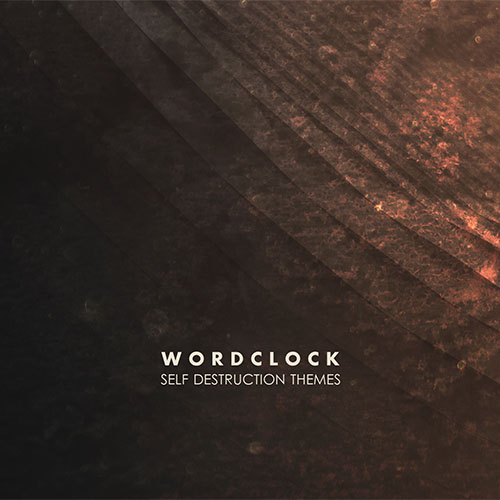You can support Terra Relicta by donating! Please, do so, and thank you!
 Band: Wordclock
Band: Wordclock
Album title: Self Destruction Themes
Release date: 15 December 2015
Label: Cryo Chamber
Tracklist:
01. Here We'll Be Gone (featuring Apocryphos)
02. The Fever Of Our Waiting
03. It May Come
04. When Indecision Strikes
05. Something More (featuring Atrium Carceri)
06. More Often Than Not
07. Every Shade
08. Something Else
09. 32 Walls
10. Lack Of Language
2015 was a massive year for Pedro Pimentel, the mastermind behind Wordclock. Starting off the year he released his debut Endless on Cryo Chamber. Endless immediately stood out as something special in the dark ambient genre showing the precision techniques of Pimentel as a producer. Endless was given a warm reception by reviewers and Simon Heath often mentioned that Wordclock would be an artist to keep an eye on. Not long after, Wordclock released the soundtrack to Noct, an indie survival horror game greenlit on Steam. The Noct soundtrack was co-written by Pedro Pimentel and Robin Finck, guitarist for Nine Inch Nails. Again, Wordclock saw heaps of praise for his work on the soundtrack, which brings much of the needed creepiness to the devastated environment of Noct. Now with his latest release, Self Destruction Themes, Wordclock presents the most refined and varied work to date.
Self Destruction Themes will immediately raise some eyebrows with the guest appearances on "Here We'll Be Gone" and "Something More" by Apocryphos and Atrium Carceri, respectively. The album kicks off with a long and quite beautiful track by Wordclock and Apocryphos. This track features serene drones coupled with comforting field recordings and Apocryphos seems to give it the added chill needed to bring it all together. This track is also our first taste of the least known yet by far the most important contributor to the album, Amund Ulvestad. Ulvestad, a classically trained cellist from Norway, gives Self Destruction Themes a deep melancholic warmth, while adding a greater connection to the human themes of the album. Wordclock's masterful use of these artists throughout his album gives it a shifting beauty which holds the listener tight, keeping them warm and comfortable with gentle drones, cello, and piano, among other instrumentation. On "The Fever Of Our Waiting" there is a slowly building momentum starting as a deep relaxing drone and shifting to a more anxious and chaotic wall of sound, finally leveling back off into a dark calm. "It May Come" is a beautifully layered track, immediately reminding me of the feeling I get from The Caretaker An Empty Bliss Beyond This World, an album I highly respect. On this track, there is a background static almost as if we are listening on an old record player. The piano sounds muddied and distant, and the cello slowly rolls in and out of the fray. "When Indecision Strikes" is a very powerful track. It seems to play tricks on the mind, lending to the masterful production of Pimentel. It is at once an industrial field recording heavy track with calming piano and cello accompaniment, yet it gives the feeling of something much larger and grander. The track reminds me of something from Chelsea Wolfe or Sigur Ros, with its strange yet gorgeous melody. "Something More" seems like the most dark ambient oriented track on the album, Atrium Carceri's touch is recognizable and the whole track gives a very haunting vibe, as if wandering through a graveyard in the middle of a cold damp night. "More Often Than Not" is the shortest track on the album coming in at only two and a half minutes, it serves as a bit of an interlude or time of reflection, while still giving all the elements of a well rounded song. "Every Shade" is the most cello focused track on the album and really showcases the talent of Amund Ulvestad as well as Pimentel's ability to seemlessly integrate it into a dark ambient track. The track is lonely, melancholic, and cold. It conjures images of some ancient castle in the frozen peaks of the Alps inhabited by a lovesick villain. "Something Else" is another cello intense track, it is beautiful yet very dark and gradually brings the listener out of the desolate cold and isolation of the previous track into the warmth and overwhelming humanity of the rest of the album. "32 Walls" is probably the most interesting track by Wordclock to date. It has a strong industrial element, with the cello accompanying in short abrupt bursts. A momentum begins to build here as a drumming almost like a heartbeat emerges. A deep and muffled voice speaks over the track, the words are not quite coherent but it is nevertheless very unsettling and brings the mind into focus after such desolate and lonely tracks earlier in the album. "Lack Of Language" is the perfect ending to this masterpiece. This track features clear synth and piano lines with a drum beat which leads the album to an energetic and triumphant ending, making the listener immediately crave more.
Self Destruction Themes is a glowing success for Wordclock and a sign that he may be the most important new artist on Cryo Chamber to follow, and indeed one of the most gifted young artists in the dark ambient genre. This claim is all the more justified when looking at the attention and praise Wordclock has received from veterans like Simon Heath and Robin Finck. Self Destruction Themes is easily recommended to listeners of many different musical styles, given its blending of classical, dark ambient, industrial, ambient, and idm elements into one impressive album. Also look out for the music videos released for "Here We'll Be Gone" and "Lack Of Language" both produced by Cesar Ramos.
Review written by: Michael
Rating: 9/10